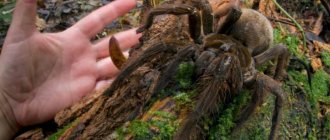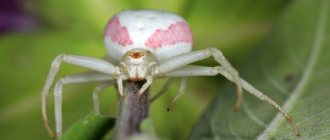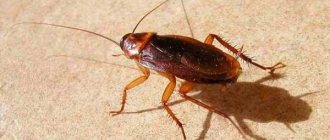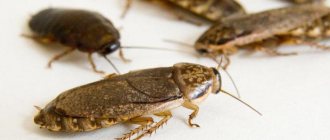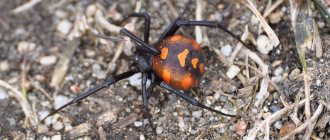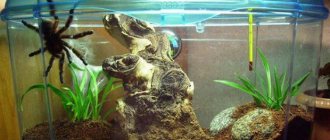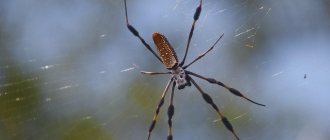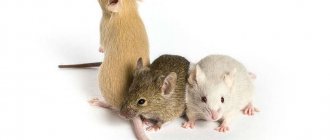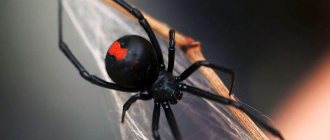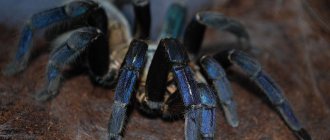What spiders can you keep at home?
Not all types of arthropods can be kept at home. Some of them are deadly poisonous, while others have an unremarkable appearance (for example, the gray spider or the haymaker spider, which most often live in secluded corners of houses and apartments). Many people choose tarantula spiders, and there are several reasons for this:
- They have a presentable appearance: large sizes, bright colors, shaggy bodies.
- This species includes more than a hundred subspecies, from which you can choose a pet to suit every taste.
- They live somewhat longer than other species.
- They can reproduce in captivity.
- The tarantula's venom does not pose a fatal threat to a healthy adult.
Popular types of tarantulas are: white-haired, two-colored, giant, striped, horned and others. In addition to tarantulas, the choice is often made of tarantulas, cross spiders, wolf spiders or jumping spiders. The listed species extremely rarely bite people (only in the event of a sudden attack), but even if this happens, their poison does not cause any serious consequences.
One of the exotic pets is the spider. Read what spiders can be kept at home and precautions.
Who can be kept at home
Recently, keeping spiders has become accessible and simple. You can choose several types.
Tarantula
A large selection of tarantula subspecies allows you to choose the ones you like. They come in hairy, hairless and even two-tone varieties. The horned and striped subspecies are unusual.
Tarantula
The lifespan of females of this species of spider is up to 30 years. Such cohabitation can last for a long time. They are unpretentious, temperamental and there is a wide choice for purchase.
Cross
Rearing can be problematic because females and males have different life expectancies. They need “summer” conditions all year round and enough free space.
Wolf
Solitary predators wandering around their territory are good hunters. They can wander into people's houses and, in case of danger, bite, but do not cause much harm.
Jumpers
A large family, among whose representatives pets can be chosen. Some of them are small and even cute. There are those that imitate ants and insects.
Where to keep
Typically, glass or plastic terrariums with good sealing are used to keep spiders. They can be of horizontal or vertical type: the former are suitable for ground spiders, while arboreal species require a vertical type of housing with effective ventilation. Therefore, it is very important to know the species of your pet in order to recreate natural conditions for it as accurately as possible.
Most species do not require much space, since they spend almost all their time passively, hiding in hollows, burrows and other shelters. However, the length of the home must be at least twice the span of the pet’s legs. In a terrarium that is too large, the pet will experience obvious discomfort and a desire to hide away.
The terrarium should also not be too high, so that if the pet falls from the walls, it will not be damaged. For example, for adult tarantulas, a container with the following parameters is quite sufficient: 30*30*20 cm. For young tarantula spiders (up to several molts old), a plastic container measuring 10*8*6 cm is quite enough. After 7-10 molts, you can buy a home larger size, based on the size of the pet.
Consider the ins and outs of keeping spiders such as the wolf spider, tarantula, black widow and tarantula at home.
It is important to understand that the space needs of spiders are fundamentally different from most of the animals we are used to - arthropods do not need much space for walking and activity.
What does a tarantula look like?
In the photo, the tarantula strongly resembles a tarantula spider, but the latter is a mygalomorphic spider and is particularly large in size.
Tarantula.
Tarantulas are quite large spiders, growing up to 10 cm in length with a body weight of about 90 g. The size of the legendary Apulian tarantulas usually does not exceed 7 cm, southern Russian relatives are much smaller and grow up to 2.5 - 3.5 cm. Females of any species are larger than males .
Tarantula.
The fluffy body of the tarantula is formed by two sections: the cephalothorax and abdomen, connected by a thin hollow bridge - a stalk. The upper part of the body is covered with a dense chitinous shell, the stomach remains defenseless. There are 4 pairs of eyes on the head, allowing one to see the blurry outlines of prey at a distance of 20–30 cm.
The long legs of predators are densely studded with sensitive hairs, which play an important tactile role in searching for prey and protect the spider from natural enemies. When in contact with human skin, the hairs can cause an allergic reaction.
South Russian tarantula or Mizgir: close-up view of the muzzle.
The protective coloration allows tarantulas to successfully camouflage themselves against the background of the surrounding landscape. Apulian tarantulas are painted in dark colors with a light edging; the abdomen of females is red, decorated with one longitudinal and several transverse black and white stripes. You can recognize the South Russian tarantula in the photo by its black belly and brown-red top.
Is it possible to keep several individuals in one container?
Under natural conditions, some species of spiders can live together, and these can even be individuals of different sexes and age groups. However, in captivity, it is not recommended to keep two or more representatives of the same species in one container - this is associated with a high risk of aggression or cannibalism, and as a result, injury or death of pets. It is also necessary to seat the babies after the first molt.
Important! Keeping spiders of different species together in the vast majority of cases ends in the death of one of the pets.
Conditions of detention: how to arrange a home
In order for an exotic pet to delight you with its presence for a long time, you need to work hard on the equipment of its home. When arranging a terrarium, it is necessary to think about lighting, decor and filling, and regulate the temperature and humidity of the air.
What is needed in a terrarium
The terrarium must have a layer of substrate. Firstly, this will help recreate a more natural environment for your pet, and he will not sit on bare plastic or glass. Secondly, the main task of the substrate is to maintain a stable level of humidity inside the container. For this reason, neither sand nor stones are suitable as a filler. The most acceptable options are vermiculite and coconut filler. Both fillers are highly hygroscopic.
- Coconut substrate is a completely organic product, it is universal, that is, suitable for any type of arachnid, and also has a pleasant appearance. The disadvantage is the possibility of developing mold or fungal infection, as well as the infestation of mites and springtails.
- Vermiculite also has advantages and disadvantages. It is very easy to notice and remove debris; it also does not harbor parasites, mold and mildew. However, vermiculite is very difficult to mark the moisture level and is not suitable for burrowing spiders. Before purchasing, you need to study the composition, as chemical impurities are possible.
For woody species, a substrate of 1-3 cm will be sufficient. Instead of filler, you can use filter paper.
But for burrowing and terrestrial varieties, you can make an area with a thicker layer of substrate (up to 5-6 cm), where the pet can dig a cozy hole for itself. The need for decoration is determined by the type of your pet. For example, for spiders that weave webs, no special decoration is required, since soon it will not be noticeable under a layer of beautiful lace. Main -
provide your pet with all the conditions for weaving. But for species that like to hide in shelters, you can buy ceramic houses, castles and shards, products made from cork oak or artificial plants.
In addition to the spider, you can also have a cat, dog, fish, parrot, hamster or guinea pig in your house.
Sealing and ventilation
It doesn’t matter what you use as a home - a food bowl or a special glass terrarium, it must be securely closed with a lid, otherwise one morning you may find that the spider’s house is empty, and its owner is walking around your apartment. But when sealing the container, do not forget that the arthropod needs fresh air and high-quality ventilation of the container, so several holes should be made in the lid through which the spider will not escape, but will gain access to oxygen. If your pet lives in a plastic container, it is better to make holes on the side wall in two rows: bottom and top. To do this, you can use a hot nail of small diameter.
Lighting
The need for decoration depends on the type of spider. For example, for tarantulas there is no need to install additional light, since they are nocturnal inhabitants who are excellent at navigating in the dark. If you want to install light, give preference to infrared lamps - their radiation is invisible to your pet. It is not advisable to choose incandescent lamps, but if you choose this option, install them outside the container to prevent the animal from being burned and the air from drying out.
Temperature
Spiders are able to tolerate a very wide temperature range. Optimal values are 23-26°C. Additional heating may be needed only during the transitional autumn-spring period, when the heating is already turned off or is not yet working. To provide heat, you can purchase special cords and heating plates, as well as a thermostat. The devices must be installed either under a container (for tree spiders) or on the walls of the house (for terrestrial species).
Important! The temperature in the room and terrarium should not exceed 31°C.
Humidity
This indicator is very important for the health and well-being of the pet. The required humidity level for each species may vary. You can determine a deficiency or excess of moisture by your pet’s behavior:
- the spider constantly sits at the drinking bowl, dragging soil into it - the container is too dry;
- the spider constantly sits on the walls of the container - this behavior indicates excessive humidity (but sometimes this may just be a favorite habit of the pet);
- the woody species descends to the substrate - the container is dry;
You should not spray the substrate with a spray bottle; instead, it is better to use a syringe without a needle or a watering can with a thin hole. It is important to determine by eye when there is enough moisture (the substrate should be 2/3 wet). Adults must have a drinking bowl in the container; choose its size in such a way that the pet cannot fit into it and drown. Keep in mind that swamp cultivation should not be allowed in the terrarium. In conditions of excessive humidity, midges, mold and fungus easily grow, which can kill the arthropod.
Clinical signs of bites
Arachnids are mainly predators, as they inject a paralyzing toxin. When in contact with a person, they behave in the same way; their protective barrier is triggered. Signs if a spider has bitten an arm or leg develop in different ways, since they depend on the type of individual.
Karakurt is considered a dangerous individual. After a black widow attack, a person experiences the following symptoms:
- strong secretion of saliva;
- headache;
- nervousness;
- muscle cramps;
- sweat separation;
- goosebumps.
These symptoms do not go away for several days. Their manifestations are determined by the body's resistance. If help is not provided to the victim immediately, severe spasms will appear for a long time, respiratory arrest and death may occur.
heavy sweatingWhen faced with a tarantula, most people are afraid of it, believing that its bite leads to death. But this is a wrong assumption. The individual's venom does not pose a threat to life, and death occurs in rare situations. The factor lies not in the toxin injected under the skin, but in an allergy to the substance. The bite of a tarantula is painful and a person develops rashes, twitching of the limbs, dizziness, decreased blood pressure and numbness in the legs and arms. If there is an allergy, then Quincke's edema and the development of anaphylactic shock are inevitable.
The hermit arachnid is a dangerous species, and even people who have a strong physical frame should beware of its attacks. Spider bites occur unnoticed, but the poisonous substance disperses throughout the body quickly. What does a recluse spider bite look like? The skin swells, increases in size, and is covered with ulcers. Without immediate action, tissue necrosis occurs. Then the victim develops the following symptoms of poisoning:
- heartbeat increases;
- temperature rises;
- nausea, vomiting;
- dizziness;
- aching joint;
- breathing is difficult.
The resulting ulcers heal poorly and take a long time.
The bite of a tarantula spider is also poisonous, but does not threaten to cause serious harm. In this case, fatal bite cases are sometimes recorded. Certain varieties of tarantula spiders that are brought into homes today are completely harmless. Even when an arthropod bites its owner, it is out of fear; it does not inject poison. A tarantula bite causes only pain and slight redness, which can be eliminated with a disinfectant.
spider bite on body
The bite of a cross spider also does not lead to the death of the victim, but a lot of negative sensations may appear. A cross bite is manifested by the following symptoms:
- feeling of apathy;
- fatigue;
- weakness;
- burning;
- swelling;
- drowsiness;
- twitching of limbs;
- chills;
- diarrhea;
- vomiting.
Signs
Often, after a spider bite, there is no sensation, but it feels like a needle prick. Basically, the initial manifestations are observed after 10-15 minutes as a white or red spot. After 2 hours, clear signs of an arachnid attack develop. The stage of severity of the symptoms will be predetermined by the type of arachnid and toxic substance.
When bitten by a poisonous individual, the following symptoms develop:
- red formations develop on the epithelium;
- muscle aches and pains;
- hyperemia;
- spasms;
- the appearance of blisters and wounds in the area of the bite;
- erosion, necrosis;
- swelling of soft tissues;
- increased sweating;
- painful feelings in the abdominal area;
- outbreaks of suffocation;
- limbs become numb and tingling;
- feeling of itching, burning;
- dyspnea.
suffocation
In case of critical damage to the central nervous system, the victim loses his mind. He salivates heavily and may stop breathing. With severe symptoms, the patient may fall into a coma. The state of health worsens due to increasing poisoning of the body.
- Temperature increases.
- The patient vomits and feels sick.
- A stool disorder appears.
- Weakness in the body.
- The victim is shivering.
- Cyanosis of the epithelium is formed.
What you need to care for a spider
So, it is obvious that to keep an exotic pet you will need the following accessories:
- sealed container made of glass or plastic;
- drinking bowl;
- filler;
- air heater;
- thermometer;
- decor (depending on the type of spider);
- a small plastic box for isolating the pet (for example, when cleaning the terrarium);
- long tweezers, 20-25 cm (for feeding and removing debris);
- long brush (helps when transplanting a pet);
- additional lighting (depending on type).
Did you know? Spiders are very useful for agriculture - their main food is insects that destroy crops. Thus, spiders annually save up to 30% of the world's harvest!
What to feed a spider at home
Spiders are representatives of obligate predators, therefore they must feed exclusively on products of animal origin. The most common food for spiders are feeding insects: various types of cockroaches (Turkmen, Argentine, marbled), larvae, mealworms. You need to buy food in specialized stores. It is not recommended to feed your pet cockroaches, flies, any insects or small animals that you have caught yourself.
Exotic animals have always been interesting to humans. Read about the top 10 most popular and rare exotic pets.
Firstly, you cannot be sure of their health (many insects can be carriers of diseases), and secondly, it may be difficult for a spider to cope with a large insect, frog or mice, and besides, such food is not familiar to it.
The frequency of feeding is determined by the age of the pet. Babies and teenage spiders need food 3 times a week, adults need to be fed 1-2 times. The size of one serving should correspond to the size of your pet's belly. However, in many cases, spiders are capable of eating much larger portions. Food must be given using tweezers; leftovers must be removed after the meal.
Important! Don't panic if your pet has no appetite.
The period of rest from feeding can last weeks or even months for some spiders. Under no circumstances should you overfeed the spider. This increases the risk of a hernia or injury if it falls from the wall of the terrarium, and such specimens are not suitable for breeding. If the pet refuses food, but its abdomen is of normal size (not sunken), there are no injuries on the body, there will be no molting soon and the conditions for keeping it are good, then you don’t have to worry.
Choosing a pet
Since the role of a pet must certainly be a bright, eye-catching specimen, accordingly, the option with our practically “native” haymaker spider immediately fades into the background. And why disturb the cute eight-legged “neighbor” by driving him into a terrarium, besides, these creatures are already domestic and probably huddle in one (in most cases, several) of the cozy corners of your house. We’ll leave them there, and for home keeping we’ll choose someone nicer, for example, a tarantula. By the way, representatives of this particular species are the most common and popular spiders for home keeping. And there are several reasons for this:
- firstly, they are very beautiful - bright colors, large sizes, shaggy body;
- secondly, it reproduces well in captivity and, accordingly, is amenable to breeding;
- thirdly, it lives relatively long;
- fourthly, this species includes several hundred subspecies, which opens up a huge selection.
On a note! The venom of a tarantula spider is not fatal for an adult healthy person, but for other pets its bite can be fatal, for example, for cats, dogs, etc. In addition, tarantula venom can seriously undermine the health of a small child and a person with allergies!
However, tarantula spiders are far from the only representatives of their order that are chosen for home keeping. In addition to them, wolf spiders, often tarantulas, cross spiders and even baby jumping spiders are also in demand.
Criterias of choice
Having come to a pet store, say, for a kitten, we roughly understand what requirements to put forward for it: clean eyes, ears, a wet nose, etc. But what about the spider? What parameters should this creature advise?
So, let's examine the spider we like. It should be:
- Active. If it is absolutely immobile for a long time or moves very slowly, then most likely this specimen is sick.
- Healthy. The health of a spider is indicated by the state of its abdomen: when dehydrated, it becomes wrinkled; in a healthy arachnid, on the contrary, it is even and smooth. You should also pay attention to the condition of the hairs in this area - in a sick spider they will be of unequal size and combed in places.
On a note! When a spider is disturbed by painful sensations, it scratches its abdomen with its hind legs, tearing off some of the fibers!
- Small. A spider of particularly large size may turn out to be old, therefore, it will not illuminate your life with its presence for long. Also, remember that males are always slightly smaller than females.
- No visible damage to the body. However, here one should take into account the fact that some types of spiders may have broken off limbs that grow back after molting.
Cleaning the terrarium
Thorough cleaning of the terrarium and replacement of the substrate is necessary every 8-12 months, as well as in the event of mold or mildew. There is no need to clean your home more often. You should always remove leftover food with tweezers after a meal. During cleaning, the resident must be transferred to a container. To do this, you need to open the terrarium and use a brush to push the spider towards the container.
Shedding period
Molting is a physiological, very important period for spiders, during which growth and renewal of the entire organism occurs. Shedding involves shedding the old hard cuticle and growing a new one. The process is started under the influence of special hormones. During the period when the new cuticle (exoskeleton) has not yet hardened, the pet is very vulnerable and defenseless.
You can understand that molting is coming soon by the behavior of the arthropod: the spider stops eating and becomes inactive. Tarantula spiders create a bed of webs for themselves, lie down on their backs and remain in this position until the shedding of the old skeleton is completed. The speed of this process depends on the age of the pet: the younger the spider, the faster the molting occurs.
What the spider owner needs to remember during the molting period:
- You should not offer food to the spider during this period - live food insects can harm your pet;
- you need to feed the arthropod no earlier than 2-3 weeks;
- Under no circumstances should you touch the spider, especially when it lies on its back;
- do not try in any way to “help” your pet get rid of the old skeleton;
- You can remove the old skeleton only after the pet turns over and stands confidently on its feet.
Juveniles that experience rapid growth molt more often than adult spiders.
If your pet has not shed for a long time, the conditions may need to be corrected. Did you know? The strength of the web is equal to steel wire. If it were possible to create a rod from a web just 0.5 cm thick, it could stop a tank or a bulldozer. The only reason this durable and environmentally friendly material is not used in industry is that it cannot be recreated in the laboratory.
How spiders molt
One of the most important periods in the life of a house spider is the period of its molting, during which time the old exoskeleton is replaced with a new one. Thus, small spiders molt once every 20-30 days, while with large spiders this happens once every few months. And here are adult female spiders - they can molt once every few years. By the way, the age of tarantula spiders is usually measured by the periods of molting they experience. So, remember this.
How to tell if a spider has started molting
As a rule, before the onset of the molting period, your spider will begin to refuse food, become inactive, and if it has a bald spot on its abdomen, it will darken, and before the start of the molting itself it will turn black. The color of the spider will become dull, and your pet will look not like a well-groomed house spider, but like some kind of goner. You shouldn’t be afraid of this - these are natural processes. Also, the spider begins to build a hammock - a web - on the ground, but if you have a tree spider, it will choose a higher place for such a construction. After this, the spider climbs into such a hammock and lies down on its back. It can lie in this state for several days. And then... a real miracle happens. The old skin in the back area begins to crack and a completely new spider crawls out of it. It is absolutely forbidden to help him during this procedure. You can simply damage the spider itself and the insect will die. If you really want to help, adjust the humidity level, then the spider will have all its legs intact, and it will be active and cheerful.
After the new spider has emerged from the body of the old one, it lies on the old skin for some time and rests; in this state, its skin is still soft and easy to injure - so you shouldn’t poke the new spider with tweezers or touch it with a brush. . After a new incarnation into the world, the spider can remain in this state from several days to several weeks. It's different for every spider. Then, it will activate and become mobile again, and you will notice that not only its color has become bright, full and more saturated, but the spider itself has grown.
When its skin hardens, the spider itself will get rid of the old skin (throw it into the corner of the terrarium). Now you can try to feed it, however, be careful - the spider after molting is very mobile and active. So make sure he doesn't escape.
Injuries during molting
If something goes wrong, and after molting the spider is left without one or more legs, do not despair, if it is young, after a few molts the leg will be restored. But, if you have an adult male, most likely he will die. Read more about spider molting here.
How many years do they live
Of course, the life expectancy of a pet will depend on how well you can create conditions for it. However, in general, with good care, spiders of various species have the following life expectancy:
- tarantulas - live on average 15-20 years;
- tarantulas - life expectancy greatly depends on the species, some in captivity live only 1-2 years, but there are varieties that can live up to 20-30 years (females live longer than males);
- cross - they live for a maximum of six months, males die after mating, females - after creating a cocoon;
- jumper - in captivity, females live up to 3 years, males live 1-2 years;
- peacock spider - lives a maximum of 9 months;
- goliaths - females live up to 8-9 years, males - up to 6 years.
The general pattern is this: large species have a longer lifespan than small species.
Is it possible to pick it up?
Most often, these questions are asked by owners of large species, for example, tarantulas and tarantulas. It should be clearly understood that spiders cannot be considered full-fledged tame animals; they are guided by physiological instincts, which is why attempts to play with a pet, train it, or try to carry it in your arms are completely pointless and doomed to failure.
You also need to realize that for a spider, a change of environment will always be very stressful, especially if the temperature, lighting and humidity of the environment differ from these indicators in the terrarium. Any careless movement can lead to injury or death of the arthropod, especially in the case of small species and babies. Some species can instantly run away from you (for example, jumping spiders), and finding a fugitive in an apartment will be very difficult. When under stress, your pet may bite you, and although the bite will not be fatal, pain is guaranteed. Spider venom can be dangerous if you have allergies (which you may not even know about).
All pets have different personalities, so some may calmly react to your attempts to invite him into your palm, while others will strive to bite as soon as you put your hand into the terrarium. Based on this, it is not recommended to attempt to pick up your pet.
Today, among pets, exotic animals are becoming increasingly popular: caecilian, tarsier, African hedgehog, earth hare, mink, capuchin monkey, wombat, kea parrot, mudskipper, nose, possums, manul, lemur, striped raccoon, mini- pig, Temminka cat and mongoose.
Answers to popular questions
Keeping spiders at home is accompanied by various emergency situations that require immediate resolution. Let's look at a few typical problems and methods for eliminating them:
Is it possible to pick up spiders? A spider cannot be called a full-fledged tame animal. Therefore, any attempts to tame or “train” a pet are initially doomed to failure. Many people wonder whether it is possible to pick up a pet. The answer is ambiguous because predicting the likelihood of a spider's behavior is difficult. A change in temperature, humidity level or amount of light can negatively affect arthropods. The result of such taming can be different: the spider will run away, bite, get scared, or even die soon.
What to do if you are bitten by spiders? Often, house spider bites do not pose a danger to humans. The exception is people with a tendency to develop an allergic reaction. In case of acute attacks of allergies and the lack of timely medical care, anaphylactic shock and even death are possible.
Typically, a house spider bite is accompanied by a slight burning sensation, itching, redness or swelling at the site of the lesion. To protect yourself from negative consequences, you need to apply a tourniquet above the bite site. The wound should be washed with water and soap and treated with any antiseptic. It is advisable to take an antihistamine. Don’t forget to drink plenty of fluids to prevent intoxication of the body.
What to do if a spider “escapes” from the terrarium? Most often, the spider leaves its home when the seal of the terrarium is broken. Also, a pet’s “escape” is possible in a stressful situation, after molting or a feeding disorder. First, it is necessary to determine the current location of the “fugitive”, only then - to carry out measures to return him to the terrarium. So, having found a spider in the room, cover the “fugitive” with a wide container. Now carefully slide a sheet of thick cardboard under the arthropod. Lift and carefully carry the structure, move the spider into the terrarium, and close the container tightly.
How long do house spiders live? The lifespan of a spider depends on compliance with the conditions of detention, proper care and feeding. This factor is also influenced by the species characteristics of the animal. For example, tarantulas, popular among spider breeders, can live 15-20 years, goliaths - 6-9 years, peacock spiders - about 9-10 months. Tarantulas, which are also actively bred at home, live in captivity from 1 year to 30 years. Life expectancy depends on the breed. In addition, females live significantly longer than males.
Danger to humans
Before you get such an undemanding pet at home, you should find out how poisonous it is. It must be remembered that although this type of spider can bite a person, these bites do not pose a danger.
The animal can bite if it feels its life is threatened, but before that it can rise on its hind legs and create menacing hissing sounds. The tarantula spider bites with chelicerae, at the end of which there are fangs, the length of which is about 2 cm. During the bite, it injects poison.
The bite site becomes inflamed, followed by swelling and swelling. All this is accompanied by pain. After about a week, the negative consequences of the bite disappear. This is especially true for people prone to allergies, as well as those with weakened immune systems. After a bite, such people experience a deterioration in their general health and severe weakness, with nausea, diarrhea, dizziness and headache.
Spiders cannot be trained in any way, so a person must study their behavior patterns. If the spider has poisonous hair, then it is better to handle it while wearing gloves, otherwise it may irritate the skin.
It is important to know! There is a category of people suffering from arachnophobia - fear of spiders. If such a person accidentally and unexpectedly encounters a tarantula spider, he may die of fear. In this regard, it is necessary to ensure that the animal is not able to leave the terrarium and does not start traveling around a person’s home, or even worse, among its neighbors.
How much does a tarantula spider cost?
These exotic animals are not that cheap, as some of the species cost a lot of money. You can purchase a tarantula spider in various ways: via the Internet or through an advertisement, or by going to a pet store. Depending on the type, you will have to pay from 100 to 10 thousand rubles. Moreover, females are always more expensive.
When choosing a pet for yourself, you should pay attention to a number of factors, including age. It is better not to buy too large individuals, as they may be old. Secondly, you should pay attention to the shell. If they are damaged or have wrinkles or cracks, it is better not to take such individuals, as they may turn out to be sick. It is not recommended to buy spiders before or immediately after molting, since it is not possible to determine how active the animal is.
Sources
- https://prusakam.net/pauk-ptitseed/
- https://beetlestop.ru/soderzhanie-paukov-doma/
- https://planetexotic.ru/zhivotnye/spiders-ulitki-nasekomye/
- https://ruspoll.ru/drugie-vrediteli/kakih-paukov-mozhno-derzhat-doma.html
- https://pets2.me/bok/1268-vse-o-soderzhanii-paukov-v-domashnih-usloviyah.html
- https://halal-eko.ru/sobaki/vidy-paukov-v-kvartire.html
- https://ogorodniki.com/article/pauk-kak-domashnii-pitomets-populiarnye-raznovidnosti-s-foto-usloviia-soderzhaniia-pravila-kormleniia-i-tonkosti-ukhoda
[collapse]
What to do if a spider bites you
As mentioned earlier, bites from spiders, which are often kept in homes, are not fatal unless you have allergies. Otherwise, anaphylactic shock may occur with the most negative consequences.
A bite is often accompanied by the following symptoms: itching, redness, pain and swelling in the affected area. Occasionally, malaise may occur and body temperature may rise. All symptoms disappear after a few days. The algorithm of actions in case of a bite is as follows:
- If a limb is affected, it must be tied with a bandage or rope above the bite.
- Wash the puncture site with soapy water and treat with an antiseptic.
- Apply an ice compress.
- Drink plenty of water to speed up detoxification.
- If necessary, take an antihistamine.
Applying an ice compress
Affectionate and fluffy pet. House tarantula spider
Tarantula spider. What's in a name?
I would really like to start an article about spiders by mentioning the fact (which should be known to everyone) that spiders are not insects. This fact cannot be ignored for the simple reason that many people still stubbornly call them that. And you can’t say that they are similar. Spiders belong to the class Arachnida, which also includes scorpions, false scorpions and ticks (yes, ticks are not insects either). These amazing creatures appeared on our planet approximately 400 million years ago in the Paleozoic. Fossilized spiders are found in Devonian and Carboniferous deposits. Moreover, these fossils are not much more primitive in structure than modern ones. Today, spiders are ubiquitous and it is very difficult to find a corner of the Earth where their four pairs of paws have not set foot.
Specifically, in this article we will talk about such a family of arachnids as tarantula spiders - these are beautiful eight-legged and hairy creatures. The tarantula family includes 10 genera containing several hundred species. Its representatives inhabited all the continents of the planet, except Antarctica, and their sizes vary from 0.8 to 20 cm with paws. Many people like to keep the largest and most beautiful ones at home as exotic pets.
It’s hard not to say a few words about the name “tarantula spiders.” After all, they don’t eat birds, and if they dine on some kind of bird, then this is the exception rather than the rule. So why are they called that? The thing is that at the beginning of the 18th century, an artist who was partial to spiders named Maria Sibylla Merian made an expedition during which she was lucky enough to catch that rare moment when a tarantula was eating a hummingbird. Amazing luck. At the end of the trip, Madame Merian published a work that included an engraving of a spider's meal. The scientific community did not believe that arachnids could eat vertebrates, but the name stuck.
A little history of how they came up with the idea of keeping a spider at home. Not a cat after all
It's no secret that people and spiders are old neighbors who have been sharing the same living space since time immemorial. But spiders only recently acquired the status of a pet. Perhaps this is due to the fact that terrarium art, as such, is a fairly young phenomenon in Russia, and also, partly, due to the fact that quite a large number of people are simply afraid of spiders. However, in vain.
However, people began studying spiders long before Joaquim. Aristotle also mentioned these amazing creatures in his writings, classifying them in his own classification system as the genus Entoma - “segmented animals with many legs,” belonging to a large group of “animals without blood.” The real flowering of arachnology came at the beginning of the 19th century thanks to the research of Latreille and Walkener. Regarding Russian arachnology, one of the first systematic descriptions was made in 1770 by E. Laxman.
The fashion itself for keeping and breeding tarantula spiders at home appeared relatively recently - in the 19th century. And since then it has been rapidly gaining momentum, which, however, is not surprising: tarantula spiders are very unpretentious in keeping, very beautiful and diverse, and it is a pleasure to watch them.
House spider. Pros, cons
If you compare the tarantula spider with any other common pet, then the obvious advantages of man’s eight-legged friend immediately emerge: it doesn’t shit in slippers, it doesn’t scream at night, it doesn’t require walks, and it takes up little space. Well, seriously, when choosing everyone’s office favorite, it’s worth taking a closer look at tarantula spiders. Even in the smallest office you can find a corner for a small terrarium (it doesn’t need a large one), and the pet will calmly endure the weekend without your attention. It doesn’t need much food or special care, and the spider’s metabolism can hardly be called fast.
There is a highly embellished disadvantage of the tarantula spider as a pet - its poisonousness. But, as they say, the devil is not as terrible as his ceremonial portrait. Most species are not that poisonous, and the consequences of their bites are actually quite boring: not exactly like a mosquito, but nothing criminal. Of course, if you don't have allergies. Typically, a tarantula bite is comparable to a wasp sting. And more poisonous species of spiders are initially recommended for keeping only by experienced arachnokeepers.
In addition to biting, the irritating hairs of the tarantula pose some danger to humans. In case of danger, fear or bad mood, the spider may begin to scratch them. Oddly enough, this is also never fatal, neither for the spider nor for its owner. When the hairs come into contact with human skin, they cause itching and irritation, in the worst case, something similar to hives. But a bouquet of unpleasant sensations is guaranteed for those who get them in the eyes. So, if you hold a spider on your hands, it’s better to wash them. Handles, not spiders.
A particularly funny example of fear of the irritating hairs of a tarantula was described in one of the American tabloid newspapers of the 90s. A local "expert" studying spider hairs was pictured wearing a spacesuit-like suit. In the article itself, he strictly warned readers to approach tarantulas without such attire. Because otherwise, the most terrible dermatitis and all 7 Egyptian plagues threaten.
It is worth writing separately about spider molting, although it is difficult to classify it as a pro or a disadvantage. This is an extremely fascinating phenomenon that deserves its own article, so now only briefly. Firstly, the molting of a spider is not something that happened suddenly: the entire life of a tarantula consists of 4 stages, each of which smoothly flows into the next, forming a continuous cycle: the pre-molting stage; direct molting; post-molt stage; interlink gap. Just before the spider molts, life is very difficult for the spider - the old “armor” is tight, it’s hard to hear and see, and there’s no way to complain to anyone. And the very process of shedding the old shell can frighten a newbie: the pet will roll over onto its back and may lie like that for some time. Do not rush to bury the tarantula - molting does not always occur instantly, and besides, dying tarantulas do not roll over on their backs. Then, like a phoenix from the ashes, the spider will rise in a brand new exoskeleton. The old skin is called exuvium.
By the way, about the exuvium. The authors of the book “The Theory and Practice of Arachnocypers” Stan and Margaret Schultz recommend not throwing it out, but carefully (since after molting the spider is very vulnerable) remove the molt from the terrarium before it dries, straighten and stuff the still wet opisthosoma (the back part of the tarantula, including abdomen) with cotton balls. This way you can create a historical display of all ages of your pet.
Keeping a tarantula
Arboreal species of tarantulas are accustomed to slightly different conditions; they need something to happily climb on. For example, driftwood or bark, so that they feel comfortable, like in their native forest. Especially jumping ones need a little more space than their terrestrial counterparts. But it’s still better not to joke with gravity. When keeping both burrowing and tree spiders, it is necessary to ensure that a certain humidity and temperature are maintained; this can be easily done using a thermometer and hygrometer. In cool rooms, artificial heating should be installed, and maintaining the necessary humidity is very simple - periodic spraying and a small drinking bowl from which the animal can safely get out without drowning.
Pros and cons of content
Before you decide to purchase such a pet, weigh the pros and cons of keeping it.
Among the advantages:
- does not require a lot of time and money for care and maintenance;
- a silent, calm and almost invisible animal;
- The behavior of the spider is interesting to observe.
Flaws:
- there is always a risk that a spider will bite or run away;
- some species have a very short lifespan;
- cannot be trained, and is not a tame pet in the standard sense.
Important! For children, the elderly, people with allergies or other serious illnesses, a spider bite can have bad consequences!
Such an exotic pet will clearly attract the attention of all visitors to your home. If you and other family members do not have arachnophobia or allergies, then it is quite acceptable to have a spider. But if you want to receive emotional feedback from your pet and spend more time with it, then you should take a closer look at more social types of animals.
